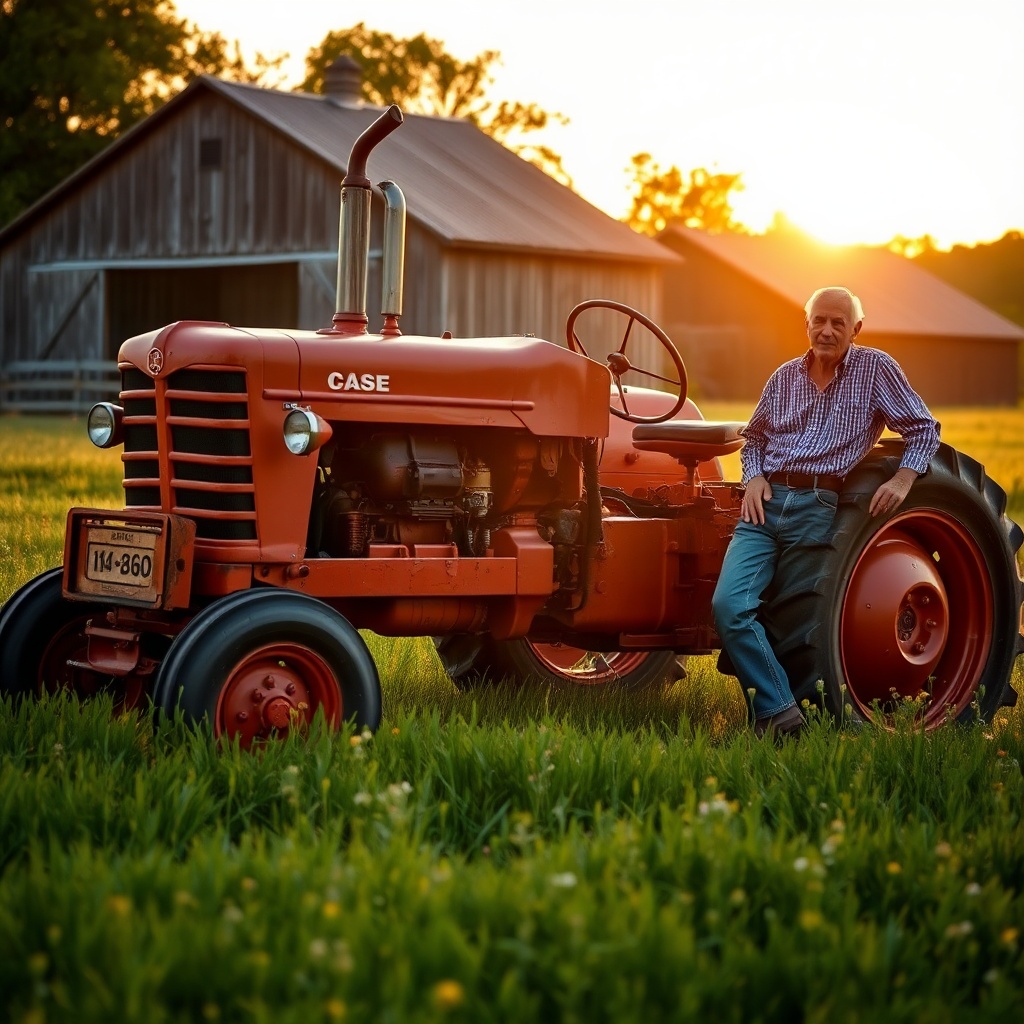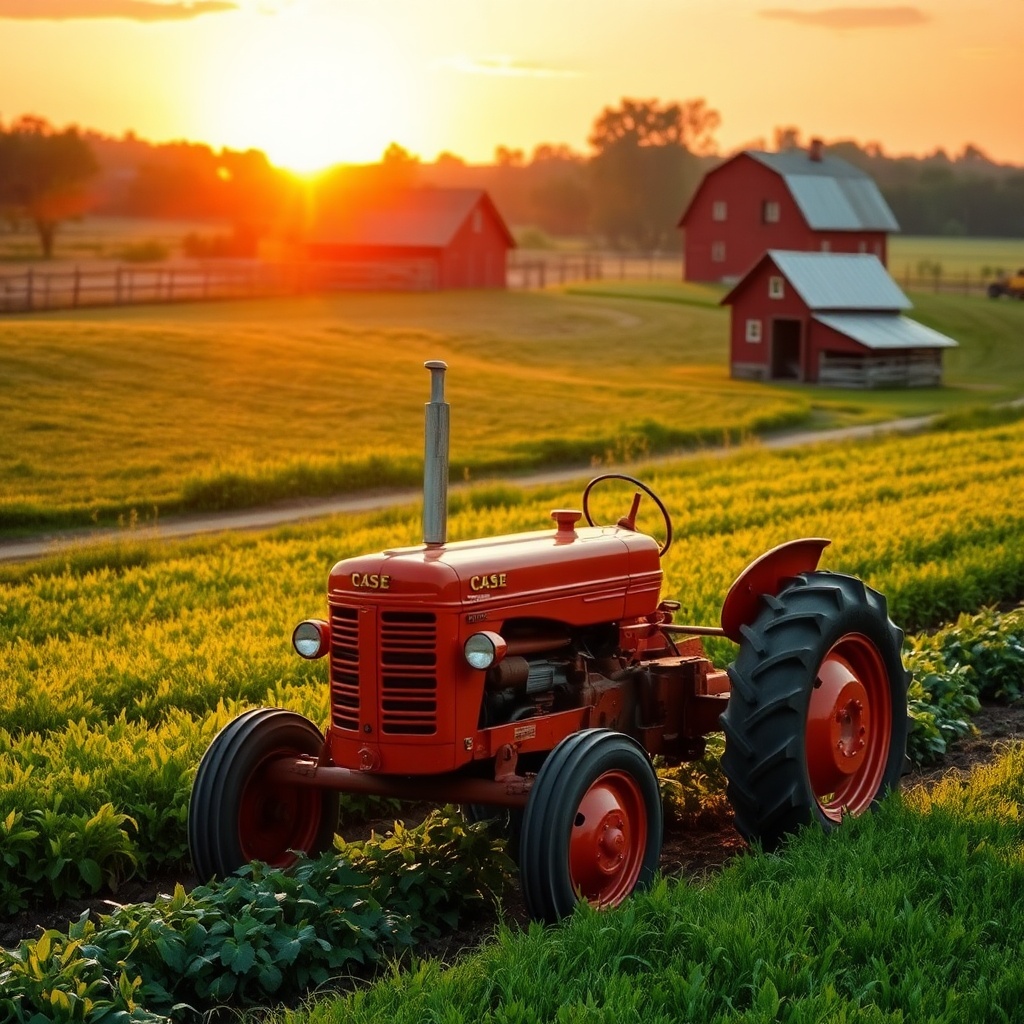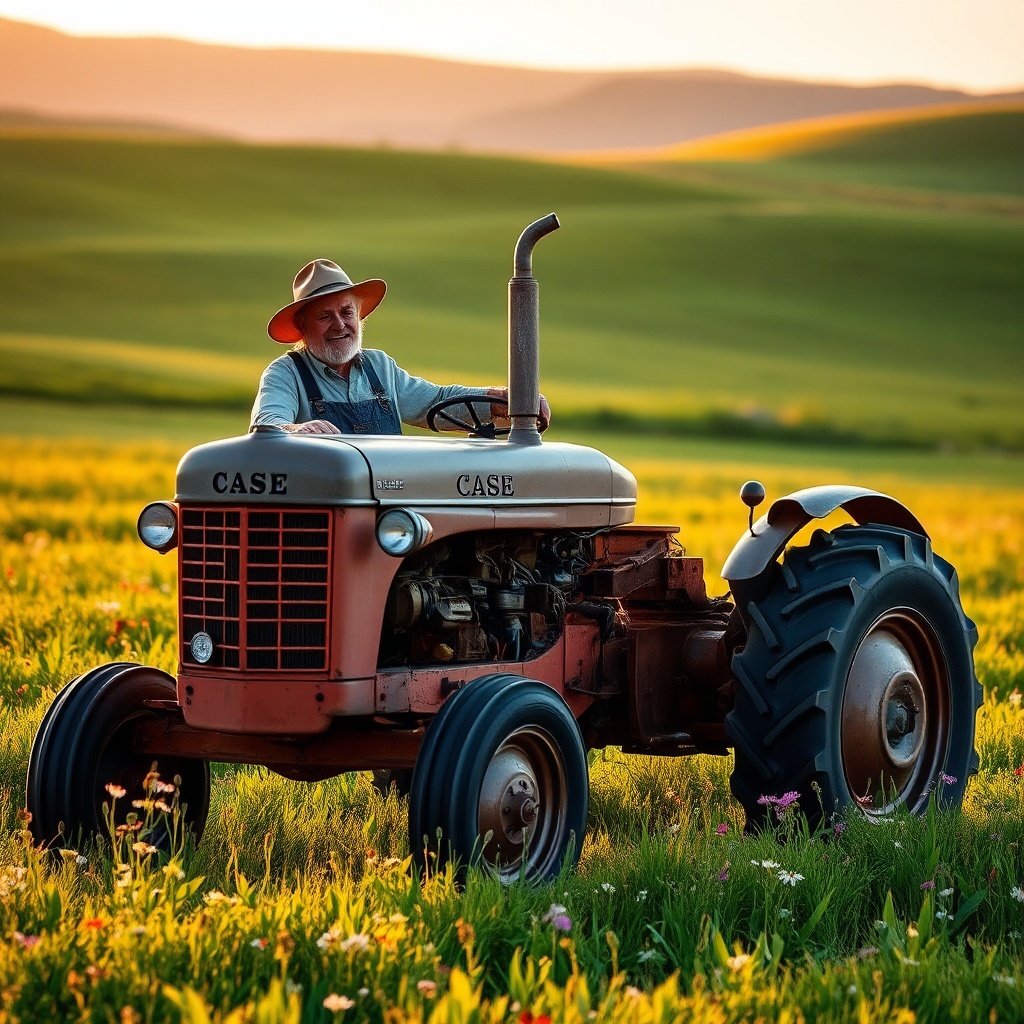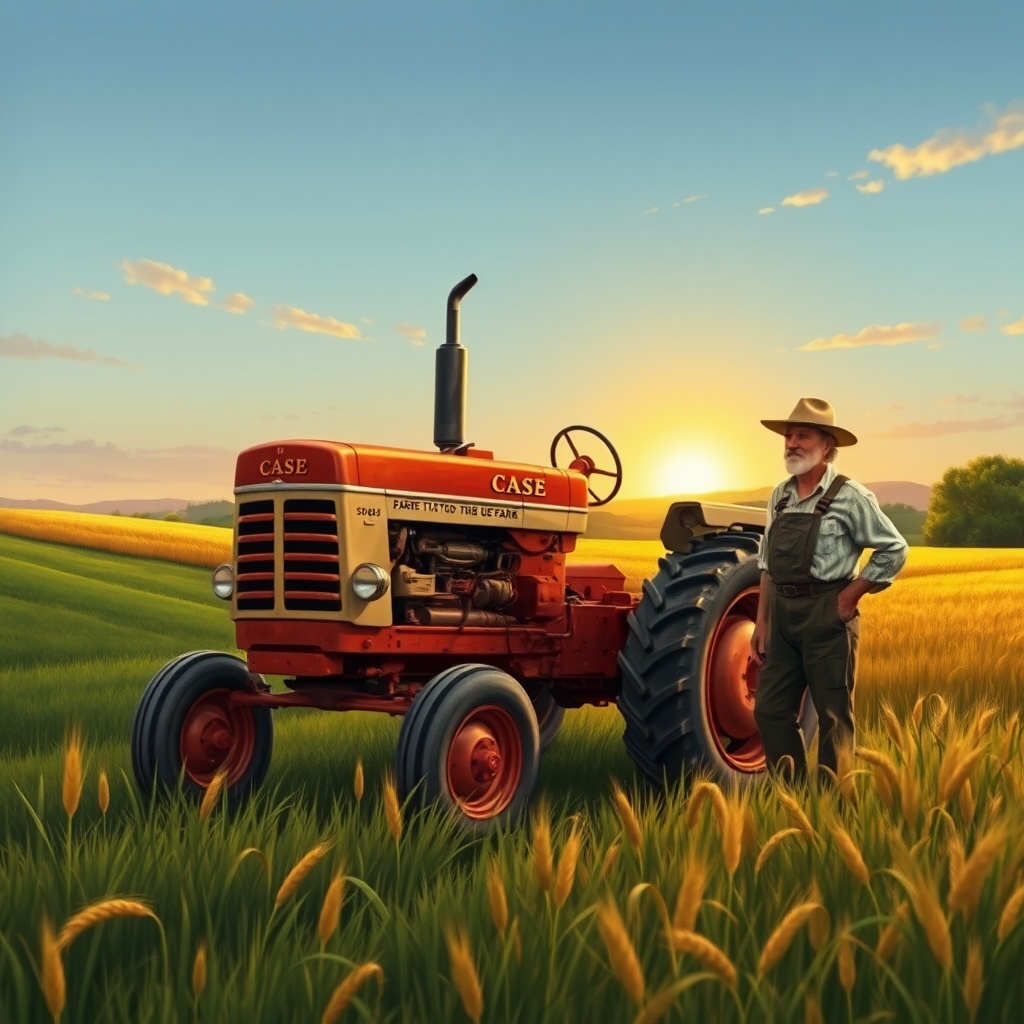Unleashing the Power: Iconic Features of 1960s Case Tractors

Introduction to 1960s Case Tractors
The 1960s were a transformative decade for agriculture, and the introduction of Case tractors played a pivotal role in this evolution. Let’s take a closer look at the features that made these machines iconic and integral to farming during that era.
1. Robust Engine Performance
One of the most striking features of Case tractors from the 1960s was their powerful engines. These tractors were equipped with:
- High Horsepower: Models like the Case 930 boasted up to 95 horsepower, making them suitable for a variety of tasks.
- Fuel Efficiency: Designed for long hours of operation, these engines provided exceptional fuel efficiency, crucial for farmers managing costs.
2. Advanced Hydraulic Systems
The hydraulic systems in 1960s Case tractors were groundbreaking. They allowed for:
- Increased Lifting Capacity: With hydraulic lift, farmers could easily handle heavy implements.
- Versatility: The ability to connect various attachments made these tractors adaptable for different farming tasks.
3. Ergonomic Design
The design of Case tractors in this era focused on operator comfort. Key features included:
- Spacious Cabs: Operators enjoyed ample space, which reduced fatigue during long hours of work.
- Adjustable Seats: Seats were designed to provide support and comfort, allowing for better control.
4. Durability and Reliability
Farmers could count on Case tractors for their durability. Some notable aspects were:
- Heavy-Duty Construction: Built to withstand tough farming conditions, these tractors were known for their longevity.
- Ease of Maintenance: Simplicity in design meant that repairs were straightforward, saving time and money.
5. Innovative Technology
The 1960s marked the introduction of innovative technologies in tractor design:
- Power Steering: This feature made maneuvering easier, particularly in tight spaces.
- Live PTO: This allowed for the use of attachments without stopping the tractor, enhancing productivity.
Each of these features contributed to the legacy of 1960s Case tractors, making them a beloved choice among farmers. By understanding these iconic features, we can appreciate the impact these machines had on the agricultural landscape.
Legends of the Field: How 1960s Case Tractors Revolutionized Farming

Imagine standing in a vast field, the sun rising over the horizon, illuminating the hard work of farmers who relied on powerful machinery. The 1960s marked a turning point in agricultural history, especially with the introduction of Case Tractors. These machines weren’t just tools; they were the backbone of a new era in farming.
The Rise of Case Tractors
In the 1960s, Case introduced several models that changed the landscape of agriculture. Let’s take a closer look at some of the most notable tractors:
| Model | Year Introduced | Horsepower | Key Features |
|---|---|---|---|
| Case 930 | 1965 | 90 | Power Steering, High Clearance |
| Case 1070 | 1969 | 105 | Torque Amplifier, Comfort Cab |
| Case 1200 | 1966 | 120 | Heavy-Duty Frame, Advanced Hydraulics |
Innovations That Made a Difference
These tractors brought several innovations that revolutionized farming:
- Power Steering: This feature made steering easier and reduced operator fatigue, allowing farmers to work longer hours.
- Torque Amplifiers: These allowed for better control of power and speed, especially useful during heavy-duty tasks.
- Comfort Cabs: Enhanced operator comfort with better visibility and soundproofing, which was a big leap from earlier models.
The Impact on Farming Practices
With the introduction of these tractors, farming practices changed. Farmers could:
- Increase Efficiency: Larger fields could be cultivated in less time.
- Reduce Labor Costs: Fewer workers were needed as tractors could perform tasks more quickly.
- Enhance Crop Yields: The ability to plow, plant, and harvest with precision led to better outcomes.
A Legacy of Strength
Today, many of these 1960s Case Tractors are considered classics. They symbolize a time when farming began to embrace machinery that made life easier for farmers. Enthusiasts and collectors still cherish these models, preserving their legacy for future generations.
The 1960s Case tractors were more than just machines; they were a revolution in the farming world. They transformed the way farmers worked and set a standard for future agricultural equipment. As you reflect on your experiences, think about how these legends of the field have shaped your own farming journey.
From Pasture to Prosperity: The Enduring Legacy of Case Tractors

The Journey Begins
Imagine waking up to the sound of a tractor humming softly in the distance. For many, that sound is a nostalgic reminder of the days when farming was not just a job but a way of life. Case tractors, especially those from the 1960s, played a crucial role in transforming agriculture.
Why Case Tractors?
Case tractors were known for their durability and innovation. They became the backbone of many farming operations. But what makes them so special? Let’s explore:
- Engineering Excellence: Designed with the farmer in mind, these tractors were built to last.
- Versatility: Whether plowing fields or transporting goods, Case tractors adapted to various farming needs.
- Community Impact: These machines helped farmers increase productivity, leading to prosperity for many rural communities.
Iconic Models of the 1960s
As we delve deeper, let’s take a closer look at some iconic models:
- Case 530: Launched in the early 1960s, it was known for its compact design, making it perfect for small to medium-sized farms.
- Case 930: A powerhouse with a robust engine, ideal for heavy-duty tasks.
- Case 1070: This model revolutionized the industry with its advanced features and comfort.
Stories from the Field
Many farmers have tales of their trusty Case tractors. One farmer recalls:
“My Case 530 was my father’s pride. We spent countless hours in the field together, creating memories that I cherish to this day.”
Technological Innovations
The 1960s were a time of great change. Case tractors introduced several technological advancements:
- Hydraulic Systems: Improved lifting capacity, making it easier to handle implements.
- Power Steering: Facilitated smoother handling, reducing fatigue during long hours of work.
The Legacy Continues
Even today, the influence of 1960s Case tractors can be seen. Many are still in operation, a testament to their durability. Farmers often share:
“I still use my grandfather’s Case 930. It’s not just a tractor; it’s a piece of our family history.”
The story of Case tractors is not just about machinery; it’s about the lives they touched and the communities they helped flourish. From the rolling pastures to the bustling markets, these tractors have left an indelible mark on farming history. As we reflect on their legacy, we celebrate not just the power of these machines, but the enduring spirit of the farmers who operated them.
Farming Heroes: The Stories Behind 1960s Case Tractors
Introduction to the Heroes of the Field
The 1960s marked a significant era in agriculture, with Case tractors leading the charge. These machines were more than just tools; they were the backbone of many farms and the heroes of countless farming stories.
The Birth of a Legend: Case 930
One of the standout models from the 1960s was the Case 930. With its powerful engine and innovative design, it became a favorite among farmers. Do you remember the first time you saw one?
Features That Made an Impact
What set the Case 930 apart? Here are some notable features:
- High Horsepower: It boasted a robust 80 horsepower, making it a powerhouse in the fields.
- Comfortable Operation: The spacious operator’s platform allowed for long hours of work without fatigue.
- Versatility: It could handle various attachments, making it suitable for plowing, cultivating, and more.
Personal Stories: Farmers’ Experiences
Many farmers have cherished memories associated with their Case tractors. Have you had a similar experience? Here are a few stories:
- John’s Harvest: John recalls using his Case 930 during the harvest season, where it helped him save time and increase his yields.
- Mary’s Family Tradition: For Mary, her family’s Case tractor symbolizes tradition, having been passed down through generations.
The Case 770: A Compact Powerhouse
Another remarkable model was the Case 770. Designed for smaller farms, it was agile yet powerful. Did you ever operate a Case 770?
A Closer Look at Its Features
Here’s what made the Case 770 special:
- Compact Design: Its size made it ideal for smaller fields and tight spaces.
- Ease of Use: Farmers appreciated its user-friendly controls.
- Reliability: Known for its durability, it was a machine that could be counted on year after year.
Legacy of the 1960s Case Tractors
The impact of 1960s Case tractors extends beyond their operational capabilities. They brought communities together, fostered friendships, and cultivated a spirit of resilience among farmers. What does your Case tractor mean to you?
Conclusion: Celebrating Our Farming Heroes
The stories of 1960s Case tractors are woven into the fabric of agricultural history. These machines represent not just power and efficiency, but also the dedication and hard work of the farmers who relied on them. Let’s celebrate these farming heroes together!
The Art of Tractor Maintenance: Keeping the 1960s Classics Running
Understanding Your Classic Tractor
Owning a 1960s Case tractor is not just about having a piece of machinery; it’s about maintaining a legacy of power and efficiency. These tractors are renowned for their robust design and reliability. However, to keep them running smoothly, regular maintenance is essential. Let’s explore some key areas to focus on.
Regular Oil Changes
Why is it important? Oil is the lifeblood of your tractor’s engine. Over time, it can become contaminated with dirt and debris, leading to wear and tear.
| Interval | Type of Oil | Recommended Quantity |
|---|---|---|
| Every 50 hours | SAE 30 or 10W-30 | 5 quarts |
Tip: Always check the oil level before starting your tractor. If it’s low, top it up before use.
Checking the Fuel System
The fuel system of your tractor is crucial for its performance. Regularly inspect the fuel lines, filters, and tank for any signs of leaks or blockages.
Tire Maintenance
Tires are often overlooked but are essential for traction and stability. Ensure they are properly inflated and check for any signs of wear.
Cooling System Care
Keeping your engine cool is vital for its longevity. Regularly check the coolant level and inspect for leaks in hoses and connections.
Electrical System Inspection
A well-functioning electrical system is key to starting your tractor. Regularly inspect the battery, wiring, and connections for corrosion or damage.
Final Thoughts
Maintaining a 1960s Case tractor may seem daunting, but with a little TLC, these classic machines can continue to serve you for many years. Remember, routine maintenance is not just about the tractor; it’s about preserving a piece of history.
A Nostalgic Journey: Remembering the Golden Age of Case Tractors
As we take a moment to reflect on the 1960s, a decade that stands tall in the annals of agricultural history, we find ourselves surrounded by the echoes of Case tractors. These machines were more than just tools; they were a lifeline, embodying the spirit of innovation and hard work that defined an era.
Imagine the sight of a Case 930 rolling through the fields, its bright red color contrasting beautifully against golden crops swaying in the breeze. Can you hear the sound of its engine, a deep, reassuring rumble that signaled a farmer’s dedication to the land? Each turn of the wheel and every pull of the plow represented not just labor, but a deep connection to the earth.
The Case 500, with its unique design and powerful performance, transformed the way farmers approached their daily tasks. Think back to how it changed the landscape of farming, allowing families to cultivate larger fields with less effort. Do you remember the feeling of pride as you watched your crops thrive, thanks to the reliability of a Case tractor?
Let’s not forget the Case 1070, a true workhorse that became a staple on farms across the country. Its advanced technology for the time—like the power shift transmission—was revolutionary. Did you ever experience the ease of shifting gears without losing momentum? It was a marvel that changed the dynamics of farming, making it more efficient and enjoyable.
As we reminisce about these legendary machines, we invite you to share your own stories and memories. What was your favorite model? Perhaps a particular day in the fields that stands out, made easier by the might of a Case tractor? These machines were not just machinery; they were part of the family, trusted companions that endured the test of time.
In celebrating the legacy of Case tractors, we honor the farmers who operated them—their stories, their struggles, and their triumphs. The golden age of Case tractors was not merely a period of agricultural advancement; it was a time of community, connection, and the relentless pursuit of progress.
So, as we look back, let’s cherish these memories. Let’s remember the laughter and the hard work, the sunrises and sunsets spent in the fields. The 1960s Case tractors weren’t just machines; they were a part of our lives, and their legacy continues to inspire generations.
The Mechanics of Success: How 1960s Case Tractors Enhanced Productivity
Introduction to Case Tractors
Imagine standing in a vast field, the sun shining down, and the sound of a powerful engine rumbling to life. This was the experience for many farmers in the 1960s, thanks to the remarkable Case tractors. These machines were not just tools; they were symbols of innovation that transformed agricultural practices.
Key Features of 1960s Case Tractors
What made these tractors so special? Let’s explore some key features:
Powerful Engines: The 1960s models came equipped with robust engines that delivered exceptional horsepower. This power allowed farmers to tackle larger fields more efficiently.
Durability: Built to withstand the rigors of farm life, these tractors were constructed with high-quality materials, ensuring they lasted through many harvest seasons.
Versatility: From plowing to hay baling, Case tractors could perform a variety of tasks, making them invaluable on any farm.
Enhancing Productivity
How did these tractors enhance productivity? Let’s break it down:
Time-Saving: With faster operation speeds, farmers could complete tasks in a fraction of the time it took with older models.
Reduced Labor Costs: The efficiency of Case tractors meant that fewer workers were needed, allowing farms to operate more economically.
Improved Crop Yields: With the ability to till soil more effectively and plant seeds with precision, farmers saw an increase in crop yields, ensuring better returns on their investments.
Real-Life Impact
Consider the story of a local farmer, Mr. Johnson, who upgraded to a 1965 Case 930. Before this change, he struggled to keep up with his fieldwork. After making the investment, he reported:
“My productivity doubled! I was able to plant my entire acreage in half the time and with much less effort.”
The 1960s Case tractors were more than just machines; they were gateways to greater productivity and efficiency in farming. Their mechanics not only revolutionized how work was done but also paved the way for future advancements in agricultural technology.
If you have memories of these powerful machines, or if you’ve experienced their impact on farming firsthand, share your stories!
Community and Connection: The Role of Case Tractors in Rural Life
In the heart of rural America, the 1960s Case tractors were more than just machines; they were vital threads in the fabric of community life. These robust machines helped shape not only the fields but also the connections among neighbors. Let’s take a closer look at how these tractors impacted rural communities.
Building Bonds Through Shared Labor
Case tractors became symbols of collaboration among farmers. The need for assistance during planting and harvest seasons created opportunities for neighbors to come together.
- Sharing Resources: Farmers would often lend a hand to each other, using their Case tractors to help with larger jobs, which fostered a sense of unity.
- Community Events: Local gatherings, such as tractor pulls and fairs, showcased Case tractors, bringing families and friends together for festivities.
Rural Identity and Pride
The 1960s Case tractors not only assisted in farming tasks but also became a proud representation of rural identity. Many families cherished their tractors as heirlooms, passing them down through generations. This connection to the past fostered a strong sense of belonging.
Education and Knowledge Sharing
As experienced farmers operated their Case tractors, they naturally became mentors to the younger generation. This knowledge transfer was crucial in preserving agricultural practices.
- Workshops: Farmers organized workshops to teach the youth about maintaining tractors, ensuring that these skills were not lost.
- Storytelling: Elders would often share tales of their experiences with Case tractors, reinforcing community bonds through shared history.
Economic Impact on Rural Communities
The presence of Case tractors in the 1960s significantly influenced the local economy:
| Aspect | Impact |
|---|---|
| Job Creation | Increased efficiency led to more productive farms, creating jobs in local communities. |
| Local Businesses | Tractor dealerships and repair shops flourished, providing vital services and contributing to the local economy. |
Conclusion: A Legacy of Togetherness
The legacy of 1960s Case tractors extends beyond their mechanical capabilities; they represent the heart of rural life. The connections formed through shared labor, pride in craftsmanship, and a commitment to community have left an indelible mark on the fabric of rural America. As we reflect on these mighty machines, we celebrate the bonds they helped forge and the stories they continue to tell.
Innovations that Inspired Generations: The 1960s Case Tractor Evolution
Introduction to the 1960s Case Tractors
In the vibrant decade of the 1960s, Case tractors emerged as a beacon of innovation, significantly transforming the agricultural landscape. These machines didn’t just aid farmers; they revolutionized the way farming was perceived and executed. Can you recall the first time you saw a Case tractor in action?
Power and Performance
One of the standout features of the 1960s Case tractors was their impressive horsepower. Models like the Case 930 and 1030 boasted powerful engines that could tackle even the toughest chores on the farm. Did you know? The introduction of the ‘Power Shift’ transmission made it easier for farmers to switch between speeds without losing momentum, making work more efficient than ever!
Innovative Design
Design in the 1960s was not just about aesthetics but functionality. The ergonomic designs of Case tractors allowed for greater comfort during long hours in the field. The spacious cabs and adjustable seats were a game changer. What was your favorite feature of the tractors from that era?
Technological Advancements
The 1960s saw the introduction of several technological advancements that would inspire generations. The hydraulic systems on Case tractors allowed for easier attachment of implements, making tasks like plowing and harvesting much more manageable. Can you think of a time when this technology saved you time or effort?
Impact on Farming Practices
With these innovations, farming practices began to shift dramatically. The ability to cover more ground in less time allowed farmers to increase their productivity and output. Have you ever wondered how these changes affected crop yields?
The Legacy of Case Tractors
The legacy of the 1960s Case tractors is felt even today. Their influence can be seen in modern farming equipment, which builds on the foundations laid by these mighty machines. What memories do you associate with Case tractors?
The innovations brought forth by Case during the 1960s not only shaped the farming practices of that era but also inspired generations of farmers to embrace technology and efficiency. As we reflect on these advancements, we can appreciate the journey that agriculture has taken and the role that Case tractors played in it.
Preserving History: Collecting and Restoring Vintage Case Tractors
Introduction to Collecting Vintage Case Tractors
For many, vintage Case tractors are not just machines; they are a link to our agricultural heritage. Their robust design and innovative features from the 1960s encapsulate a pivotal era in farming history. Are you ready to embark on a journey of collecting and restoring these magnificent machines?
Why Collect Vintage Case Tractors?
Preserving History: Each tractor tells a story, preserving the spirit of the past. Collecting these vintage machines allows you to keep history alive for future generations.
Personal Connection: Many collectors have fond memories associated with these tractors, whether it be from childhood or during their farming years. Restoring them can be a deeply personal journey.
Community Engagement: Joining a community of fellow enthusiasts can be rewarding. Attend shows, swap stories, and learn from each other’s experiences.
Steps to Start Your Collection
1. Research: Begin by learning about the different models produced in the 1960s. Some popular models include:
| Model | Year | Horsepower |
|---|---|---|
| Case 830 | 1965 | 80 |
| Case 930 | 1966 | 95 |
| Case 1070 | 1969 | 105 |
2. Join Clubs: Consider joining a vintage tractor club. These organizations often host events and provide resources for collectors.
3. Finding Tractors: Look for tractors at auctions, estate sales, or online marketplaces. Don’t rush; the right tractor is worth the wait!
Restoration Process
Restoring a vintage Case tractor can be a fulfilling experience. Here’s a general guide to get started:
1. Assessment: Inspect the tractor thoroughly. Identify areas that need repair, such as the engine, transmission, or bodywork.
2. Cleaning: Begin by cleaning the tractor to assess the extent of rust or damage. Use a pressure washer or scrub with soapy water.
3. Parts Replacement: Source original parts whenever possible. Websites and local clubs can be invaluable resources for finding authentic components.
4. Painting: Once repairs are made, consider a fresh coat of paint to restore its original glory. Use high-quality paint designed for tractors.
Sharing Your Passion
Once your restoration is complete, it’s time to share your passion with others:
1. Showcases: Participate in tractor shows to display your work and meet fellow enthusiasts.
2. Online Communities: Share your progress on social media or join forums dedicated to vintage tractors. Your journey can inspire others!
Collecting and restoring vintage Case tractors is more than a hobby; it’s a way to preserve history and connect with a community. With each restoration, you’re not just bringing a machine back to life; you’re keeping a piece of agricultural history alive. Are you ready to take the plunge?
